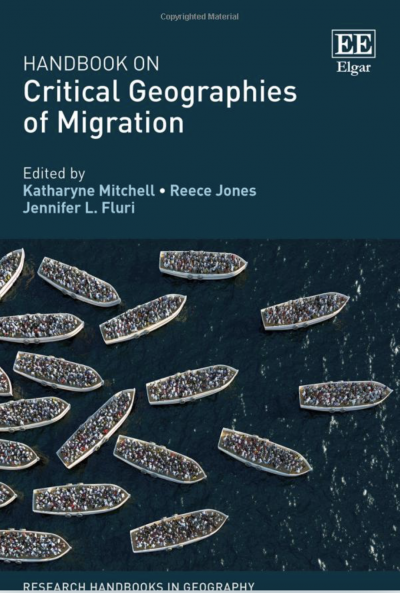Post by Sarah M. Hughes, Vice Chancellor’s Research Fellow at Northumbria University. Her current research focuses upon conceptualisations of resistance within the UK asylum system. In addition to this research, she has pursued an interest in questions around resistance, knowledge production and what constitutes ‘the political’ through collaborative work examining the politics of memory related to the London bombings and the politics of knowledge curation in the case of Chelsea Manning. She is on Twitter as @Sarah_Hughes90
Review of Handbook on Critical Geographies of Migration edited by Katharyne Mitchell, Reece Jones, and Jennifer Fluri (Edward Elgar Publishing 2019)

The process of reviewing the Handbook on Critical Geographies of Migration has facilitated a series of conversations with strangers. I read this book whilst traveling myself, and pulling it from my backpack on trains, airplanes and buses as I crossed (inter)national borders with relative ease, often sparked lively discussions with those around me. “What,” I was asked, “is Critical Geographies of Migration?” “Why Geography? Why Critical?”
I mention this attention, for it is indicative of both the importance and timely nature of Mitchell, Jones and Fluri’s edited collection. Bringing together the work of leading scholars in the field, the volume offers “a comprehensive overview of key themes in spatial and geographical scholarship in migration” (p.1) and cuts across a rich seam of conceptual framings, methodological approaches and geographical regions to provide a genuinely cutting edge collection that remains attentive to the underlying politics of contemporary migration debates.
As migration scholarship is frequently (and importantly) interdisciplinary, this volume’s focus upon Geographyis a welcome consolidation of the main contributions from this spatial science. The book is helpfully organised into thematic sections, which are illustrative of the key areas of activity within Geographical migration research. For example, Part 1, New issues in critical migration research reflects upon the contribution of Geography and Geographers, and provides a refreshing focus upon future developments in the field. Therefore Gilmartin and Kuusisto-Arponen explore the border and the body to “reflect upon the theoretical and scalar shifts that have occurred within critical approaches to migration in geography” (18). Whilst at first glance it may appear counter-intuitive to begin an edited volume with a discussion of future research directions, it speaks to the clarity and confidence of this intervention. Starting with the future steers the reader to navigate the interventions that follow with the trajectory of Geographical scholarship on migration in mind. For example in Chapter 9, Ehrkamp et al. explore how trauma is experienced by Iraqi refugees. They interrogate how PTSD becomes a ubiquitous diagnostic tool, and move to dislodge the idea of trauma as ‘the refugee condition’. Grounding this within a women’s memoir, their chapter speaks to the privileging of space in Geographical literature on migration. This is because Ehrkamp et al “demonstrate how a relational understanding of trauma”, whereby trauma is understood to extend from a singular body, and intersect with wider scales, spaces and people, “unfolds an intimate, affective, geopolitics that cannot be extracted from historical geographies of US imperialism, war, and displacement” (118).
In addition to foregrounding the Geography of migration, the contributions this handbook are attentive to the importance of the critical. Understood as more than simply negative, or rehearsing the (necessary) critiques of migration policy, the empirical and conceptual richness of the research that grounds this edited volume provides both a nuanced and a powerful intervention into the academic debate surrounding the many forms of violence produced by migration governance systems across the globe. In the Australian context for example, Coddington demonstrates that “while the reach of Australia’s border continuum appears extensive and the practices encompassed within it actively shrink refugees’ access to asylum, it too contains fissures” (233) that make visible spaces for change to occur. Comparatively in the US detention system, Martin reviews “a series of spatial practices of migration control” (244), including detention centres, electronic monitoring and the expansion of migrant categories, and thereby tracing the growing, strategic, linkages between criminal justice and immigration enforcement systems and arguing that they serve to ‘widen the net’ of containment and deportation for people on the move in the United States.
Critical Geographies of Migration is thus an important consolidation of, and contribution to, scholarship on migration. The breadth of topics covered in this edited volume however, also speaks to audiences beyond its Geographical grounding. For example, while Gill et al. examine their research undertaken in the appeals courts of the UK asylum system, through a geographical lens, they also outline a set of conceptual resources useful for anthropologists, sociologists, and legal scholars). These include unpacking the “concepts of absence and presence” in the context of asylum seekers often being unable to advocate for themselves or understand the situation that they are in (14). Therefore Gill et al. examine “how different forms of presence might be translated into the legal context” offering insights for those legal scholars and anthropologists who traditionally rely upon bodily presence (14). It is this simultaneously explicit basis within critical geographical scholarship and its contribution to fields beyond Geography, that makes the Critical Geographies of Migration an imperative read for academics and students interested in migration and the contentious politics of its governance. I am sure that it will continue to spark conversations, both within and beyond the academy.
Any comments about this post? Get in touch with us! Send us an email, or post a comment here or on Facebook. You can also tweet us.
__________
How to cite this blog post (Harvard style)
Hughes, S (2020). Book Review: Handbook on Critical Geographies of Migration. Available at: https://www.law.ox.ac.uk/research-subject-groups/centre-criminology/centreborder-criminologies/blog/2020/05/book-review [date]
Share:








